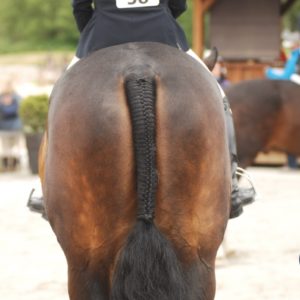For the uninitiated, “the jog,” as it’s often referred to, was a required part of certain recognized hunter divisions at USEF-rated competitions. Riders who’d placed in a class were called back and asked to stay by the ring to jog their horses before the judge as a final soundness check before prizes were awarded. During the Covid-19 pandemic, the ‘jog rule’ was postponed, then abandoned altogether—with mixed opinions on how it’s impacted the sport. Here, Dana Hart-Callanan weighs-in.
As a trainer, I think many of us have found it quite convenient that we are no longer required to wait around for “the jog.” We can move on to the next part of our day more quickly—and our child and adult riders can too! In my opinion, that’s a good thing for a lot of reasons. Horse can be put away much faster, grooms can move on to their next horse or task. All and all, the convenience that’s come from removing the jog has been huge.
I can understand the frustration involved when you’re watching a horse start off flatting in the schooling ring, and maybe it’s not 100%, and then at the end of a class that horse’s name is called for the blue ribbon. The reality is, many horses will work out of these kinds of “rusty joint” issues, so that, by the time that horse has warmed up, jumped all 8-10 jumps, and finished their closing circle in front of the judge, he or she is likely feeling more comfortable and, for all intents and purposes, is “sound.”
My question, then, would be: Would the same horse still be considered “sound” if it sat for a long time, and then had to do it all over again? Maybe not. Which is why, as a trainer, I feel that it’s my job to manage these issues for my horses. I am in control, and I will not let a horse compete if he or she is not 100% comfortable. I can’t say that’s true for every barn that I know. But my staff and I love that—with the jog a thing of the past—when our horses are finished for the day, they get to relax and go home!
As a judge, I laugh every time I judge a “jogging” division. In my experience, it’s actually a very small percentage of horses that will come into the ring with questionable soundness, jump all the jumps required, and then end unsound. In reality, it’s typically the opposite: 99% of the time they end sounder than they came in—and I know the feeling!
If I sit down for a while and then get up, lots of times I am “lame” until I walk a couple of circles and work out of it. At the end of the day, for the horse, jumping and cantering and increasing the heart beat and adrenaline typically improves soundness overall. But don’t get me wrong; as a judge, I’d love a better way to protect the horses I see competing in my ring and make sure that they are happy and comfortable doing their jobs.
One thought might be to increase the judge’s focus on a horse’s entrance in the class before they begin jumping, when their odds of appearing uncomfortable are more likely. If a horse doesn’t look right to a judge at any time, we could be given the right to call the steward, and explain why we are not using that horse in a particular class—perhaps therefore preventing that horse from competing further that day.
It’s also worth noting that the closing circle is supposed to be done at the trot in front of the judge (it often isn’t) as a means of checking soundness as well. But, like the jog, by the time it gets to that point, horses are more likely to have worked out of their issues anyway.
As a mom, this one doesn’t have many direct implications on me, personally. But again, I love the convenience. Thinking back, I’ve spent so many days and nights sitting around, waiting forever with my kid and her poor horse because they had a good round. Ironically, the “reward” for that performance is that neither of them are getting put to bed on time!
To me, there are so many things in the industry that we can do to improve the welfare of our horses. For those competing in the top divisions, this is even more important. But at least from where I stand, jogging is only a small and superficial piece of that puzzle, and was never really that effective in protecting moderately lame horses in the ring.
The expediency we’ve gained from doing away with the jog is far greater. And, when it comes to true welfare, if we’re thanking our horses by getting them out of the hot sun and back in their stalls in front of some hay and water more quickly, more the better.




 March 4, 2024
March 4, 2024 






















